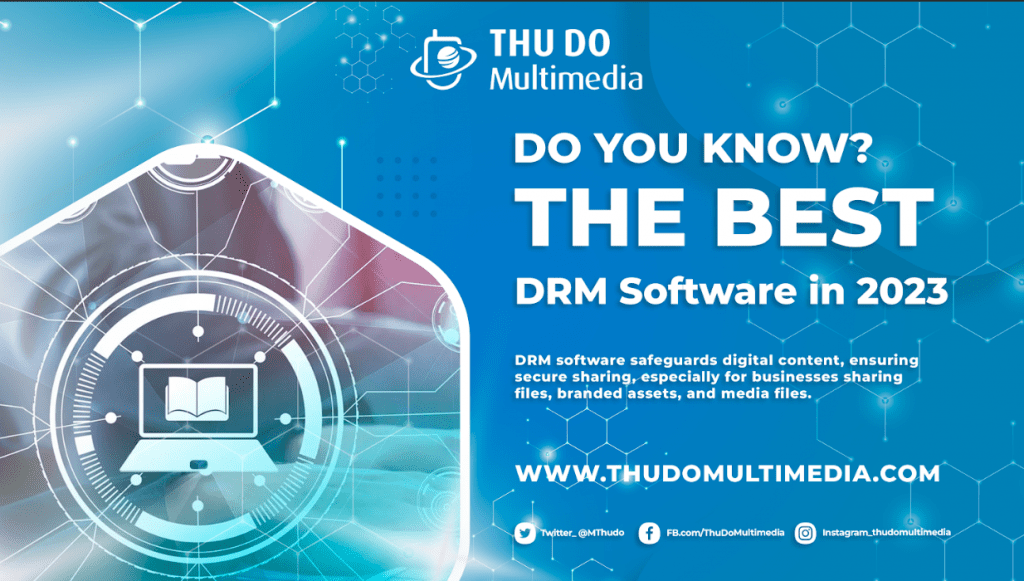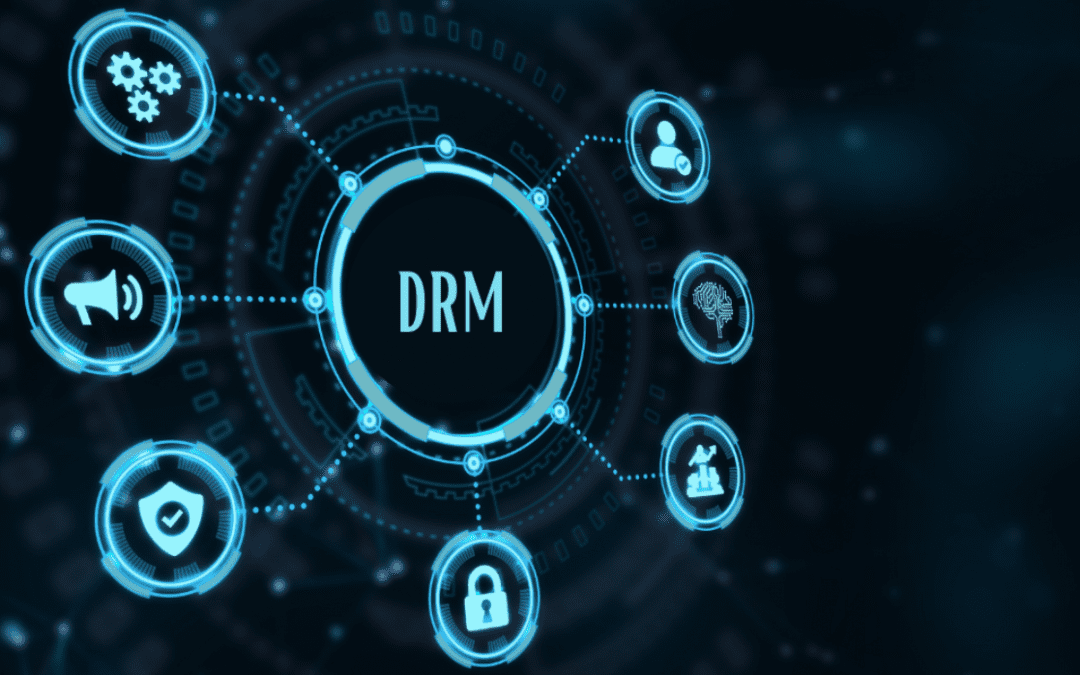Digital Rights Management (DRM) is a versatile technology that is widely employed to safeguard various types of digital content. It serves as a protective barrier against unauthorized access, copying, and redistribution of copyrighted materials.
Understanding DRM
Digital Rights Management refers to a set of technologies and practices designed to provide key benefits: to control access to digital content and protect it from unauthorized distribution and piracy. This content can encompass a wide range of digital media, including music, movies, e-books, software, and more. DRM solutions are employed by content creators, publishers, and distributors to safeguard their intellectual property and ensure that only authorized users can access and use their digital products.
How DRM is utilized across different forms of media?
- Video Streaming: Major streaming platforms like Netflix, Amazon Prime Video, and Disney+ rely on DRM technologies like Widevine and FairPlay to secure their content. These systems ensure that only paying subscribers or authorized users can view the streamed content.
- Music Streaming: Services like Spotify and Apple Music use DRM to control the playback of songs, preventing users from downloading and distributing copyrighted tracks without proper authorization.
- eBooks: Publishers and authors employ DRM to protect eBooks from piracy. This ensures that only individuals who have purchased or borrowed the eBook can access and read it on their devices. Popular eBook platforms like Amazon Kindle have their own DRM systems in place.
- Software: Software companies often implement DRM to prevent unauthorized copying and distribution of their applications. This is especially common in the gaming industry, where digital rights protection is used to combat software piracy.
- Video Games: DRM measures are prevalent in modern video games, preventing users from playing pirated copies and ensuring that players have a legitimate license to access game content and features.
- Old DVDs and Blu-rays: Even older forms of media like DVDs and Blu-rays used DRM to restrict copying and playback on unauthorized devices. These protections were aimed at preventing mass duplication of physical discs.
How DRM Works?
At its core, DRM operates by encrypting digital content and attaching specific usage restrictions and permissions to it. These restrictions can include limitations on the number of devices the content can be accessed on, the duration of access, and the ability to copy or share the content. To access DRM-protected content, users typically need a decryption key or a license, which is granted upon purchase or through a subscription service.
DRM systems can use various encryption methods, including symmetric and asymmetric encryption, to protect the content. Symmetric encryption uses a single encryption key for both encryption and decryption, while asymmetric encryption relies on a pair of keys: one for encryption and one for decryption. This complexity makes it difficult for unauthorized users to access and manipulate the content without the necessary keys or licenses.
Here are some commonly used encryption methods:
- DRM Content Encryption: The DRM process begins with the encryption of digital content using DRM technology. This DRM encryption transforms the content into a format that is unreadable without the appropriate DRM decryption key. This step ensures that the DRM-protected content remains secure during transmission and storage, making it difficult for unauthorized users to access or view it.
- DRM Player Requests Decryption Key: To access DRM-protected content, a user interacts with a DRM media player or application. When the user attempts to access the DRM-protected content, the DRM player sends a request for the DRM decryption key to the DRM content server or DRM license service. This DRM key is essential for unlocking and decrypting the DRM-protected content.
- DRM License Service Authenticates User: The DRM license service, which is part of the DRM system, plays a central role in DRM. It is responsible for authenticating the DRM user and determining whether they have the rights to access the requested DRM-protected content. DRM users typically obtain a DRM license when they purchase the DRM content, subscribe to a DRM service, or fulfill certain criteria set by the DRM content provider. The DRM license service verifies the DRM user’s identity and checks the DRM usage rights associated with their DRM account.
- DRM Server Provides Key to Permitted DRM Users: Upon successful DRM authentication, the DRM license service grants the DRM user access to the DRM-protected content by providing the necessary DRM decryption key. Importantly, this DRM key is specific to the DRM user, their DRM device, and the DRM content they want to access. This DRM approach ensures that only authorized DRM users can decrypt and view the DRM-protected content.
- DRM Player Uses Key to Decrypt DRM Content: With the DRM decryption key in hand, the DRM media player or DRM application can now decrypt and render the DRM-protected content for the DRM user. The DRM content is unlocked and made accessible for viewing or usage according to the DRM rights and restrictions defined in the DRM license. These DRM rights might include limitations on copying, sharing, or the duration of access.
The Significance of DRM
- Protecting Intellectual Property: DRM is instrumental in safeguarding the rights of content creators, enabling them to control how their creations are used and distributed. Without DRM, digital content would be vulnerable to piracy and unauthorized distribution, potentially leading to financial losses for creators and content providers.
- Enabling New Business Models: DRM allows for the implementation of various business models, such as pay-per-view, rental, and subscription services. Content creators can tailor their offerings to different customer segments, providing flexibility and monetization opportunities.
- Ensuring Compliance: In sectors like healthcare, finance, and education, DRM ensures that sensitive and confidential information is protected and complies with industry regulations. This is crucial for maintaining trust and security in these sectors.
- Supporting Cross-Platform Access: DRM solutions often offer cross-platform compatibility, allowing users to access their purchased content on different devices and platforms. This enhances the user experience and flexibility while still maintaining content security.
- Fostering Innovation: Content creators are more likely to invest in producing high-quality digital content when they have confidence that their work will be protected. DRM encourages innovation and creativity by providing a level of security.
DRM: Challenges and Controversies

While DRM serves important functions, it has not been without its share of controversies. Some argue that DRM can be overly restrictive, limiting users’ ability to enjoy their purchased content fully. Additionally, there have been instances where DRM systems have been cracked, leading to unauthorized distribution despite protective measures.
Despite the limitations of DRM, DRM is increasingly popular as content creators and distributors across various industries continue to rely on it to safeguard their digital assets and revenue streams in an ever-expanding digital ecosystem. If you are interested in DRM, you can search for the best and most reputable DRM service providers in 2023 here.
By encrypting digital content and managing access through licenses and permissions, DRM enables the continued production of high-quality digital media while ensuring that creators are fairly compensated. However, the debate over the balance between protection and user freedom continues, making DRM an ongoing topic of discussion in the digital age.


Recent Comments